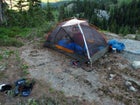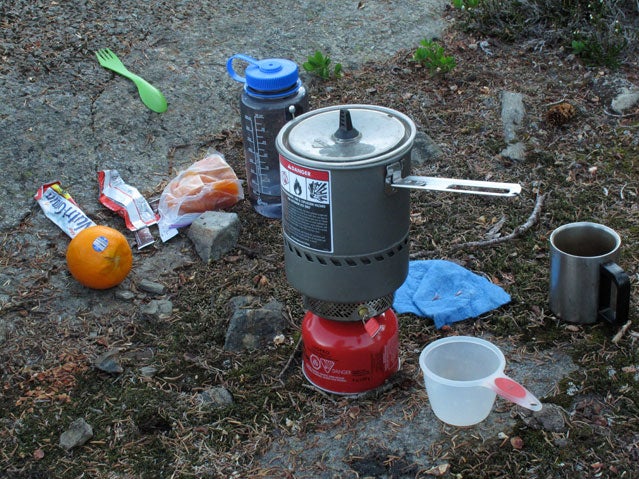As is so often the case, context is everything. My approach is to pack as little as possible, but still enough to manage conditions, handle an emergency, and stay comfortable. That makes me a medium packer, not a super-light packer.
Campsite near Lake Mary
 Campsite near Lake Mary
Campsite near Lake MaryI just returned from a three-day trip into Washington’s central Cascades, where I hiked to Lake Mary in the state’s Alpine Lakes region with my firend Michael. The hike to the lake is ten miles, with 3,300-feet in elevation gain. Neither number is terribly alarming, but something about this hike really takes it out of me.
As a result, I aimed to pack on the light side. Before our departure, Michael, who has never backpacked in Washington’s mountains, peppered me with questions about what he needed.
Pre-trip, the weather forecast looked fantastic: clear and sunny skies with highs in the upper 70s at 5,000 feet. In these conditions, even a tent would have been optional, but we still carried my REI Quarterdome T2 ($279), largely to keep away bugs. With some risk of a thunderstorms and not much natural shelter at our 6,000-foot campsite, I packed the fly, too.
Here’s what I brought:
- My tent, a light, self-inflating sleeping pad (Therm-a-Rest Prolite Plus, $99), a light sleeping bag (Mont-Bell Super Spiral #3, rated to 30, 1 pound 5 ounces).
- Minimal cooking gear: MSR Reactor Stove ($160, insulated cup, plastic bowl, spoon/fork combo). We were fine with one eight-ounce fuel canister to boil water for coffee, oatmeal, and freeze-dried dinners. The Reactor won’t “cook” anything, but that forces me to save weight by not carrying a small skillet and a package of eggs. We also took a water filter, the MSR MiniWorks ($90).
- The essentials:. A Swiss Army knife, a headlamp, spare batteries, a small first-aid kit, waterproof matches, a lighter, a map, and a compass. An altimeter watch also helped keep me oriented on the map.
- Enough clothing for the worst. I figured that the worst would be a thunderstorm, so I took a light base layer, hiking shorts, a fleece sweater, a light Gore-Tex shell, light gloves, and a beanie. Most of it I knew I wouldn’t use, it’s awfully easy to get complacent and I’d want it if I got stuck or something went wrong.
- Food. One of the “10 essentials” is extra food, which I covered by throwing in a few Clif bars. Otherwise, for breakfast I brought Nutri-Grain bars, dried fruit, and Starbucks Via instant coffee, which is the greatest backpacking innovation since the close-cell foam pad.
- Lunch was bagels and peanut butter, salami, trail mix, and fruit. I’m a believer in freeze-dried dinners, like Mountain House Spaghetti with Meat Sauce, which is $6 and reliably edible. I also had a few snacks, including some dried fruit, trail mix, and a Snickers bar.
- Beverages: Okay—I carried a few cans of Budweiser.
- In the personal essentials department, I brought a lightweight toothbrush, a small pack towel, hand sanitizer, bug spray, and sunscreen.
I do have my weaknesses, like a Therm-a-Rest Pillow ($20), Crocs, which are easy-to-don camp shoes, and a camera, a Canon G11. Otherwise, though, I try hard to fight “gear creep”— the tendency to pack stuff because it looks cool, fun, or useful.
My target pack weight before food and water was 18 pounds. I could have done better, but that’s a reasonable load and it gave me a margin of comfort and safety. Everything packed nicely into a Gregory Z55 ($229), a terrific mid-size pack with 3,500 cubic inches of capacity. I carried most of our common gear, like the tent, stove, filter, and first-aid kit. Michael carried a fuel canister and our tent poles.
For footwear I opted for my mid-weight Scarpa Kailash boots ($198), which are fantastically comfortable and perfect for a medium load on reasonable terrain. I also hike with carbon trekking poles. On my recommendation, Michael got a pair of 2009 Komperdell carbon poles at REI-Outlet for $100. A great buy, although they’ve been discontinued. At the trailhead I made him leave his plate, some extra base layers, a dishwashing kit that had caught his eye, his utensil set save a spoon, and a multi-tool.
The road to the trailhead was washed out, so we parked the car at 11 A.M., biked five miles to the trailhead, and began hiking at noon.
The verdict? My memory was correct, and the hike was hard. Over the final five miles, where the elevation gain really hits, we had to go over, under, and around 50 downed trees. Then, where the trail gets sketchy at 4,500 feet, we hit maybe a half mile of head-high brush and couldn’t see where we were walking. We staggered into the campsite around 7 P.M., and I was so tired I could barely eat. Even with Jungle Juice, which is 98 percent DEET, the bugs were horrible. My bites have bites. The payoff was complete isolation, though—we saw only one other person the entire trip.
I think we got the gear about right. My shorts and lightweight t-shirt were fine on the hike up, some light Ex Officio long pants were handy for log-jumping, and when it got cold at night I wore a long-sleeve Patagonia Silkweight Capilene T, and a Polartec 100 sweater. No need for the Gore-Tex. The Quarterdome kept the bugs out, and allowed for great star-gazing. The Reactor used maybe one-third of the eight-ounce fuel canister. The Kailashes were perfect for the trail, and the poles came in very handy on rough stretches.
And those Buds? They tasted mighty good.
—Doug Gantenbein


